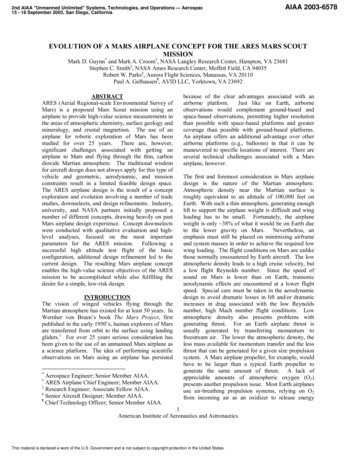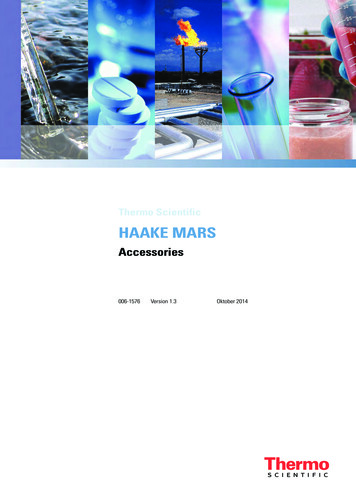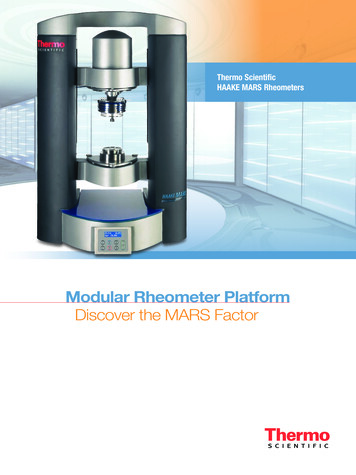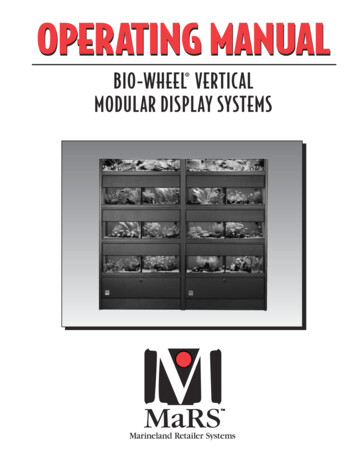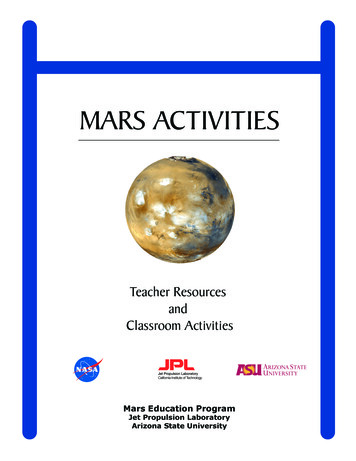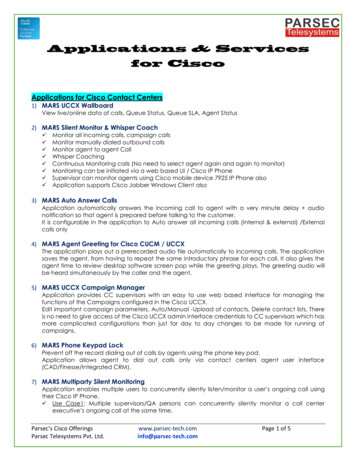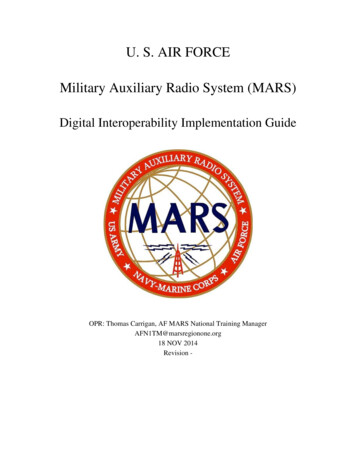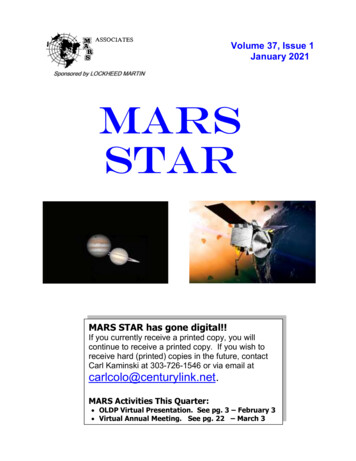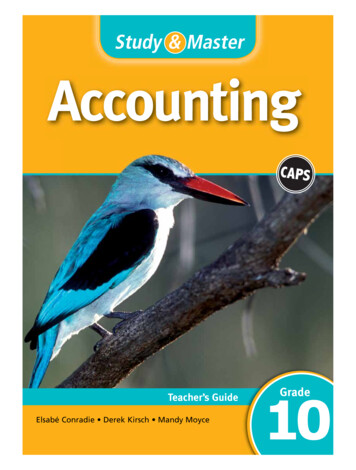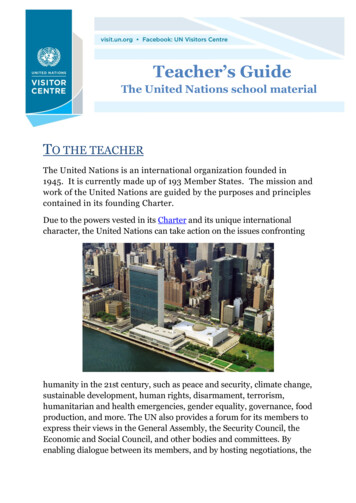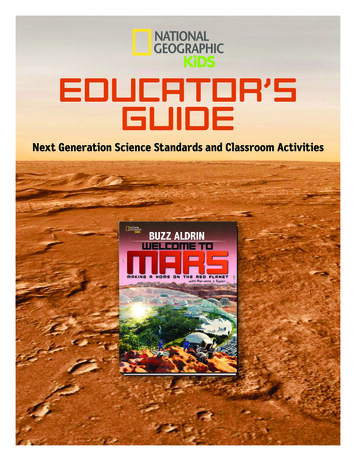
Transcription
EDUCATOR’SGUIDENext Generation Science Standards and Classroom Activities1
In this fascinating book, hero-astronaut Buzz Aldrin challenges you to think aboutMars as not just a faraway red planet but as a future home for Earthlings!! Whatwill your new home be like? How will you get there? What type of job can you get?What will your bedroom look like? What will you eat for breakfast? Find out what lifemight be like far from Earth as you navigate your way through this fun book.Hi! I’mBuzz Aldrin.I was one of thefirst people to walkon the moon. Next,I want humans tosettle Mars.Instructional Note:The Next Generation Science Standards (NGSS)are built on the Core Disciplinary Ideas (CDIs) ofthe Framework for K-12 Science Education. In thisEducator’s Guide, activities introduce, review, orotherwise address one or more of the CDIs used asthe basis for the NGSS performance expectationsfor each grade level.22THIS ART SHOWS THE MARS SCIENCELABORATORY ENTERING MARS’S ATMOSPHERE.
Grade 2ESS2.B: Plate Tectonics and Large-Scale System Interactions Maps show wherethings are located. One can map the shapes and kinds of land and water in any area.MATERIALSLOWELL OBSERVED MARS THROUGH A TELESCOPE AND CREATEDTHIS MAP, SHOWING DARK LINES HE CALLED “CANALS.”Interpreting MapsRead aloud Chapter 2, “Off to Mars.” As you read,pause to discuss relationships among the text,photos, captions, and illustrations.After reading the chapter, return to the section“Canals on Mars” on pages 28-29. Guide students torecognize that Percival Lowell created this map afterobserving Mars through a telescope. Invite studentsto identify different features they see.Display the globe. Encourage students to compare theglobe with the map. Invite students to feel the globe.Guide them to recognize that raised areas representmountains. Flat areas represent plains. Challenge students to explain how Lowell most likely used what he knewof features on Earth when he created his map of Mars.Divide the class into two groups. Give each group alarge piece of thick cardboard. Invite groups to usethe art supplies to create a landscape with a variety ofdifferent topographical features, using the cardboardas a base. Encourage them to give each group member A topographical globe Two large pieces ofthick cardboard Art supplies, includingtape, glue, scissors,markers, modeling clay,paper sacks, plastic sacks,cardboard tubes,construction paper, pipecleaners, tissue paper,newspapers, and eggcartons (You may wishto have students bringmaterial from home.) Graph papera chance to contribute to the design. Discourage themfrom viewing the other group’s work.Display the finished landscapes on desks at the far endof the room. Give each student a piece of graph paper.Instruct students to draw a basic eye-level map of theother group’s landscape. Collect the finished maps.Give students a second sheet of graph paper. Encouragethem to view the landscapes from above and draw a newmap of the same landscape. Collect the finished maps.Display each map. Invite students to identify each mapas eye-level or an aerial view. Challenge them to matcheach map with the correct landscape. Encourage themto identify features that helped them make theirdecisions. Post each map above the correct landscape.Have students compare the drawings. Discuss howdistance and perspective can affect what people see.Discuss how prior knowledge of features can affectwhat people THINK they see. Guide students torecognize how these factors—and limited technology—influenced Percival Lowell’s ideas about Mars.33
Grade 3PS2.A: Forces and Motion The patterns of an object’s motion in various situationscan be observed and measured; when that past motion exhibits a regular pattern,future motion can be predicted from it.MATERIALS A piece of cardboardthat is 8 inches (20 cm)square A marker or pen A tape measure oryardstick (meterstick) Two small toy cars,preferably blue for Earthand red for Mars! Two pieces of string oryarn, one about 20 inches(50 cm) long, and oneabout 25 inches (63.5cm) long A round pencil, preferablynot sharpened TapePatterns of MotionRead aloud Chapter 1, “All Aboard!” As you read, pauseto discuss relationships among the text, photos,diagrams, and illustrations.After reading, guide students as they complete the“Race Around the Clock” activity on pages 18-19. If youwant students to conduct this activity in small groups,gather multiple quantities of each supply.PHOBOS CIRCLES MARS ABOUT EVERY EIGHT HOURS.A CREW PERCHED ON PHOBOS COULD REMOTELYCONTROL ROVERS ON THE SURFACE OF MARSAND PREPARE THE FIRST BASE FOR OCCUPATIONAS WELL AS EXPLORE PHOBOS ITSELF.Remind the class that NASA’s goal is to build a city on Mars.Invite students to predict how many years they think thismight take. Then explain that the Aldrin cycler—like anytrain—will have a schedule and limited seating. Review thechapter to identify the best time to go to Mars (every twoyears and two months) and how many people can go oneach trip (six).Based on these limitations, challenge students tocalculate how long it would take to build a city of moreAfter completing the activity, review the section “TheAldrin Cycler” on pages 20-21. Point out to the class that than 100 people. (36 years, 10 months; Every 13 years, shipsin the activity, Earth and Mars moved clockwise. Challenge can complete 6 trips, carrying 6 people each. So every 13students to explain why the planets are moving counter- years, 36 people could arrive on Mars. In 26 years, the population would double to 72. It would take five more trips, orclockwise in this diagram. If necessary, prompt students10.10 years, to send more than 100 people to Mars.)to review the note in Step 1 on page 19. (Answer: In theactivity, students viewed the planets from “below,” look- Encourage students to explain in their own words howing “up” at the solar system. In the illustration, they arepatterns of planetary motion determine how and whenviewing the planets from “above,” looking “down.”)people from Earth could settle on Mars.44
Grade 4ESS3.A: Natural Resources Energy and fuels that humans use are derived from naturalsources, and their use affects the environment in multiple ways. Some resources are renewableover time, and others are not.EARLY GREENHOUSES ON MARS MAY GROW PLANTS INSOIL OR WATER WITH NUTRIENTS FROM EARTH, ORLATER SUPPLIED BY ROCKS FOUND ON MARS.MATERIALS Art supplies, including poster board 1 digital video camera per groupNatural ResourcesBrainstorm with students to identify naturalresources that people on Earth need tosurvive. Then give each student a Venndiagram. Instruct students to label one side“Earth,” the other side “Mars,” and the middlesection as “Both.”Invite students to read Chapter 4, “Riches ofMars,” in pairs, small groups, or on their own.As they read, challenge students to identifyand record information about naturalresources in their Venn diagrams.SKIING ON FROST AND GAS MIGHTBE A POPULAR SPORT ON MARS.After reading, divide the class into smallgroups. Instruct group members that theirjob is to create an instructional “Welcome toMars” video that people will watch as theyprepare to live on the red planet.Inform students that all scripts should addresssurvival, recreation, and at least one othertopic as it relates to natural resources foundon Mars. Encourage groups to be thorough yetcreative in how they deliver the information.Give students time to write their scripts,create backgrounds and props, and film theirinstructional videos. Then have groups sharetheir videos with the class. Encouragestudents to discuss how the change in naturalresources will impact the lifestyle of peoplemoving from Earth to Mars.55
Grade 5ESS2.B: The Roles of Water in Earth’s Surface Processes Nearly all of Earth’savailable water is in the ocean. Most freshwater is in glaciers or underground; only a tinyfraction is in streams, lakes, wetlands, and the atmosphere.PANORAMIC IMAGE OF MARS FROM VIKING 1The Search for WaterGive each student several small sticky notes. Invitestudents to read Chapter 3, “Approaching Mars,” inpairs, in small groups, or on their own. As they read,encourage students to insert a sticky note each timethe text makes a reference to water.After reading, divide the class into small groups.Instruct group members to compile their findingsinto a bulleted list of facts about the search forwater on Mars. Then brainstorm with students tocreate a list of important questions related towater on Mars. For example: Why is it important to know if Mars had waterin the past? What have people done to search for wateron Mars? Where have people found water on Mars?Instruct each group to select one question. Usingtheir notes from the chapter as a foundation, givegroups time to conduct research to learn moreabout their topic. Encourage students to gather66facts, photos, and other items to support theirfindings. Challenge them to make valid connectionsbetween their topic and knowledge of water on Earth.Rejoin as a class. Explain to students that communication plays an important role in scientific progress.Scientists often specialize in very specific fields,so they participate in conferences to share whatthey know.Guide the class in a scientific conference aboutwater on Mars. After groups present their findings,encourage classmates to ask questions. Challengeexperts to provide scientifically valid answers. Towrap up the conference, challenge groups to explainwhy knowledge of water on Earth is essential tofinding water on Mars.MATERIALS Small sticky notes Access to online researchmaterials
Middle SchoolLS2.C: Ecosystem Dynamics, Functioning, and Resilience Ecosystems are dynamic innature; their characteristics can vary over time. Disruptions to any physical or biologicalcomponent of an ecosystem can lead to shifts in all its populations.Martian TimelineInvite students to read Chapter 5, “Martian Home,” inpairs, small groups, or on their own. As students read,encourage them to pause to discuss relationshipsamong the text, photos, and illustrations.After students finish reading and discussing thechapter, have them read and review the book’sconclusion, “Green Mars,” on pages 88-89. Guidestudents to recognize that Chapter 5 describes life inthe first Martian settlement. The time line describeshow changing environmental conditions on Mars affectpeople’s lives over a 1,000-year period.Divide the class into six groups. Assign each group onesection of the time line. Using Chapter 5 as an example,instruct groups to write a new chapter for the book0100When we first arriveon Mars, the air willbe too thin and theradiation level too highfor people or plants tosurvive on the surface.People will live insidepressurized domes orcylinders covered bydirt or with filteredglass to blockradiation.200300During our first 100years on Mars,human factories willrelease gases. We mayalso crash comets intoMars to release ammonia and heat, and usespace mirrors to meltthe ice at the southpole. All these thingswill help thicken theair and warm Mars.400500After about 200years, the air may bethick and warm enoughto thaw the ice trappedin soil, and also blockharmful radiation. Thenmicrobes, algae, andlichens can grow on thesurface. Clouds might getthick enough to producesnow or freezing rain.describing life on Mars duringtheir assigned time periods.MATERIALSProvide access to colored pencils, Colored pencils Markersmarkers, and paper. Encourage Papergroups to write about and createillustrations showing people’shomes, food, and daily activities. Challenge students toinclude scientific reasons to explain how changes in theMartian ecosystem impact people’s daily lives duringthat time period.Give students time to complete their chapters. Whenall groups are finished, invite them to share theirchapters with the class. Then discuss how changing thecharacteristics of Mars can make it a more suitableenvironment for human populations over time.600Within about 600years, the simpleplants would haveproduced enoughoxygen and preparedthe soil enough thatmore complex plantslike evergreens mighttake root. Enough icewill melt to create lakesand rivers.700800Between 600 yearsand 1,000 years,Mars’s atmosphere andsurface will continueto change. More lakesand rivers will be filledwith liquid water. Moreplants will begin totake root, creatingmore oxygen and usingmore carbon dioxide.9001,000About 1,000years after humansbegin terraformingMars, the air may bethick enough thatthey can go outdoorswithout a space suit.People may stillrequire breathingmasks depending onthe levels of oxygenand other gases.77
StandardsGrade 2ESS2.B: Plate Tectonics and Large-Scale System InteractionsMaps show where things are located. One can map the shapesand kinds of land and water in any area.Grade 3PS2.A: Forces and MotionThe patterns of an object’s motion in various situations can beobserved and measured; when that past motion exhibits a regularpattern, future motion can be predicted from it.Grade 4ESS3.A: Natural ResourcesEnergy and fuels that humans use are derived from natural sources,and their use affects the environment in multiple ways. Someresources are renewable over time, and others are not.Grade 5ESS2.B: The Roles of Water in Earth’s Surface ProcessesNearly all of Earth’s available water is in the ocean. Most freshwateris in glaciers or underground; only a tiny fraction is in streams, lakes,wetlands, and the atmosphere.Middle SchoolLS2.C: Ecosystem Dynamics, Functioning and ResilienceEcosystems are dynamic in nature; their characteristics can varyover time. Disruptions to any physical or biological component of anecosystem can lead to shifts in all its populations.8
Martian Timeline Invite students to read Chapter 5, “Martian Home,” in pairs, small groups, or on their own. . instruct groups to write a new chapter for
